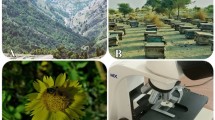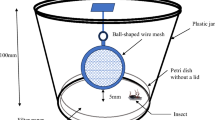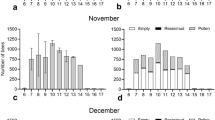Summary
Sting autotomy occurs only in certain species of highly social Hymenoptera.
When applied, the phenomenon of sting autonomy results in death for the individual demonstrating it but is added protection for the colony as a whole when the intruder is a vertebrate.
Among species in which sting autotomy occurs, it is applied in colony defense and not as an offensive mechanism.
As a defensive mechanism, sting autotomy is best employed against vertebrate intruders but would work disadvantageously in colony defense against raiding insects.
The acquisition of lancet barbs represents a case of convergent evolution among bees, wasps and ants in the order Hymenoptera.
Résumé
L'autotomie de l'aiguillon est présente seulement chez certaines espèces d'Hyménoptères sociaux avancés.
Le phénomène d'autotomie de l'aiguillon amène à la mort l'individu qui le démontre. Cependant, il fournit à la colonie la protection contre un intrus vertébré.
Parmi les espèces qui la manifestent, l'autotomie de l'aiguillon est employée pour la défense de la colonie et non pour l'offensive.
L'autotomie de l'aiguillon comme processus défensif est mieux utilisée contre les intrus vertébrés. Mais elle serait un désavantage pour la colonie à se protéger contre les insectes pilleurs.
L'acquisition du dard barbelé représente un cas de l'évolution convergente parmi les abeilles, les guêpes et les fourmis, dans l'ordre d'Hyménoptères.
Similar content being viewed by others
Literature Cited
Hermann (H. R.) andBlum (M. S.), 1967. — The morphology and histology of the hymenopterous poison apparatus. II.Pogonomyrmex badius (Formicidae).Ann. Entomol. Soc. Amer.,60, p. 661–668.
Hermann (H. R.), 1968. — The hymenopterous poison apparatus.Dasymutilla occidentalis (Hymenoptera: Mutillidae).J. Georgia Entomol. Soc.,3, p. 1–10.
Hermann (H. R.) andMullen (M. A.), 1970. —The hymenopterous poison apparatus. XI.Xylocopa virginica (Hymenoptera: Apidae).Entomol. News. (in press).
Janzen (D. H.), 1967. — Interaction of the bull'shorn acacia (Acacia cornigera L.) with an ant inhabitant (Pseudomyrmex ferruginae F. Smith) in eastern Mexico.Univ. of Kansas Sci. Bull.,47, p. 315–558.
McCook (H. C.), 1879. — The natural history of the agricultural ant of Texas.Lippincott's Press, Philadelphia, 300 p.
Rau (P.), 1933. — Jungle bees and wasps of Barro Colorado Island.Pub. by the author.
Rettenmeyer (C. W.), 1963. — Behavioral studies of army ants.Kansas Univ. Sci. Bull.,44, p. 281–465.
Sakagami (S. F.) andAkahira (Y.), 1960. — Studies on the Japanese honeybee,Apis cerana cerana Fabricius. VIII. Two opposing adaptations in the post-stinging behavior of honeybees.Evolution,14, p. 29–40.
Wheeler (W. M.), 1910. — Ants.Columbia University Press, New York. 663 p.
Williams (M. W.) andWilliams (C. S.), 1964. —Collection and toxicity studies of ant venom.Proc. Soc. Exp. Biol. Med.,116, p. 161–163.
Williams (M. W.) andWilliams (C. S.), 1965. —Toxicity of ant venom, further studies of the venom fromPogonomyrmex barbatus.Proc. Soc. Exp. Biol. Med.,119, p. 334–336.
Author information
Authors and Affiliations
Rights and permissions
About this article
Cite this article
Hermann, H.R. Sting autotomy, a defensive mechanism in certain social Hymenoptera. Ins. Soc 18, 111–120 (1971). https://doi.org/10.1007/BF02223116
Issue Date:
DOI: https://doi.org/10.1007/BF02223116




